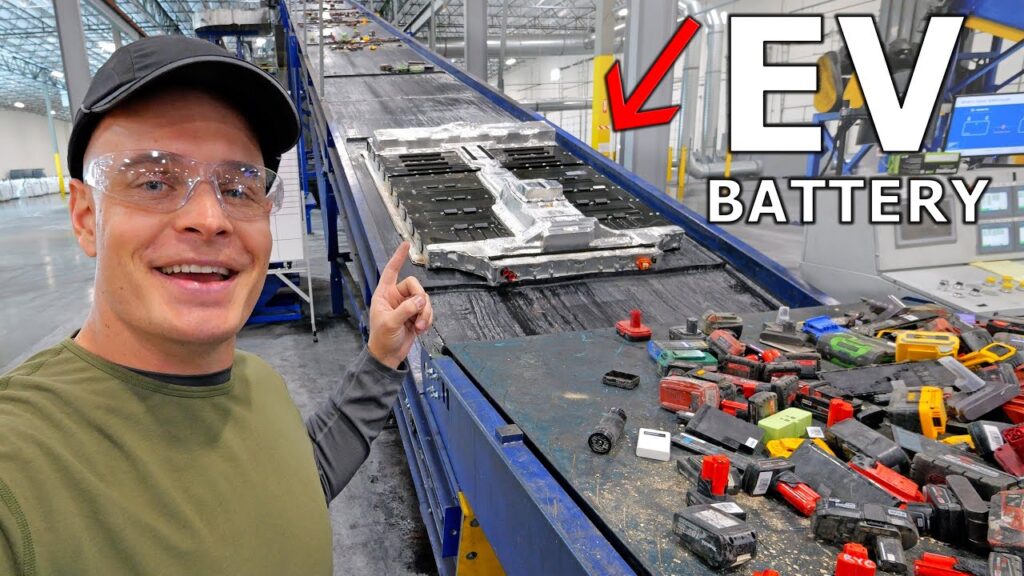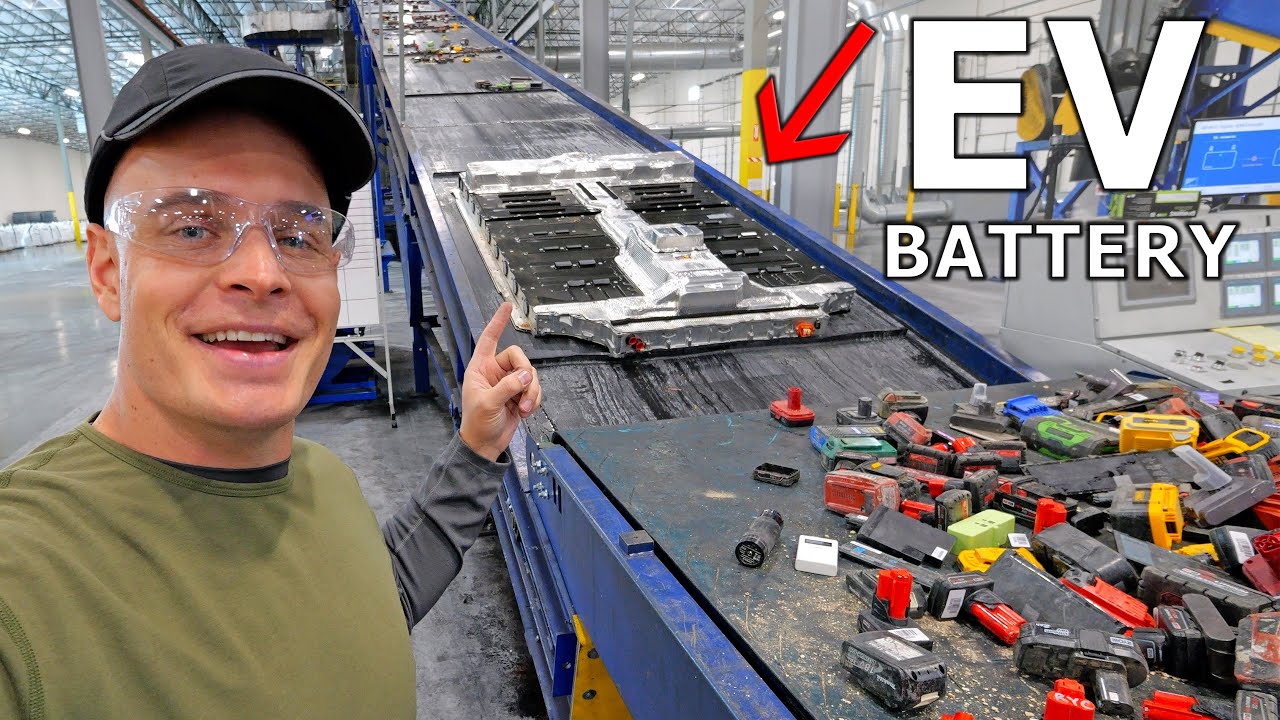In the video “What Really happens to used Electric Car Batteries? – (you might be surprised)” by JerryRigEverything, you’ll get answers to some burning questions about what happens to lithium batteries when they reach the end of their life. Joined by life cycle, North America’s leading lithium-ion battery recycler, the video takes you on a tour of their facility in Gilbert, Arizona, where they specialize in recycling both small and large batteries, including electric vehicle (EV) battery packs. The process is fascinating, with the batteries going through shredding, filtering, and pressing to extract valuable materials like lithium, cobalt, and nickel. It’s a closed-loop system that ensures no air pollutants are released and valuable metals are not wasted in landfills. Join JerryRigEverything to discover the surprising truth about what happens to used electric car batteries.
In the captivating video, you’ll learn about the various stages of the recycling process, from the battery packs being shredded to the extraction of precious metals like cobalt, lithium, and nickel. You’ll also witness the separation of plastic from the battery materials and the environmentally-friendly practices employed by life cycle to ensure that valuable resources are recycled and reused. With a dose of humor and a wealth of information, the video will debunk myths and demonstrate the importance of proper battery recycling. Don’t miss out on this eye-opening exploration by JerryRigEverything, so hit that subscribe button and embark on a fascinating journey into the world of electric car battery recycling.
Introduction
Have you ever wondered what happens to the lithium batteries inside your cell phone, tools, or electric vehicles at the end of their life? Are they thrown in landfills or recycled? These are important questions that deserve answers. In this article, we will explore the fascinating process of recycling electric car batteries, specifically focusing on the work done by LifeCycle, North America’s leading lithium-ion battery recycler. Prepare to be surprised by what really happens to used electric car batteries!
Overview of the Recycling Process
LifeCycle is at the forefront of lithium-ion battery recycling, specializing in handling large EV battery packs. They are capable of recycling batteries in any state, even those that have been damaged or recalled. This means that whether it’s a cell phone battery, a laptop battery, or a power bank, LifeCycle can recycle it. However, the largest batteries they deal with are electric car batteries, which can weigh thousands of pounds.
To understand the recycling process, let’s start at the beginning. The electric car battery pack is prepped for shredding by being transported on a conveyor belt to a funnel filled with a proprietary liquid. At the bottom of the funnel is an industrial shredder, completely submerged in the liquid. The entire battery pack, including the metal casing, plastic interiors, and the lithium, cobalt, and nickel inside the batteries, goes into the shredder without being disassembled.
Once the batteries are ground up, they go through a process that transforms them from a charged state to a completely inert state. This means that there is no electricity left in the materials after the shredding process. The shredded materials then flow through a vibrating screen where plastic is separated from the battery components. The plastic is collected and dropped into recycling bags for further processing.
The Shredding Process
The decision to keep the battery pack intact during the shredding process is crucial for the safety of the human operators involved. Disassembling the pack manually would expose the operators to potential risks. By shredding the batteries as a whole, LifeCycle ensures the safety of their workers.
Once the batteries are ground up, they transform into small metal flakes that sink to the bottom of a tank. These metal flakes are then conveyed out of the liquid, where they are collected. The collected materials include aluminum, steel, copper, and sometimes even precious metals like gold, platinum, and palladium that come off the circuit boards. All these metals are bagged and set aside for recycling.

Separating Metals
The process of separating metals is an important step in recycling electric car batteries. The metal flakes that sank to the bottom of the tank are carefully collected. This step ensures the recovery of valuable materials like aluminum, steel, copper, gold, platinum, and palladium.
These collected metals are bagged and set aside to be recycled. It is essential to note the value and usefulness of these metals. They should never be thrown into landfills because of their potential for recycling and reuse.
Extracting Cobalt, Lithium, and Nickel
To extract valuable metals like cobalt, lithium, and nickel, LifeCycle employs a filter press. The metal-rich liquid from the shredding process is pumped into a large blue press. The proprietary liquid is then hydraulically squeezed out of the press, leaving behind something called “Black Mass” on each filter.
The Black Mass is considered the most valuable part of the entire recycling process. It contains cobalt, lithium, and nickel, which are essential ingredients for producing new batteries. The Black Mass falls down the chute as the filters are shaken, and it is collected for further processing.
The Environmental Impact
One of the key benefits of the recycling process at LifeCycle is its minimal environmental impact. The system utilizes a closed-loop water system, meaning that none of the water used in the process leaves the system. This reduces water waste and ensures the efficient use of resources.
Furthermore, the process results in reduced emissions compared to traditional mining methods. By recycling and reusing battery materials, LifeCycle generates 70% less emissions in the production of batteries compared to mining them from the earth for the first time. This commitment to sustainability and environmental responsibility is a core value of LifeCycle.
The Future of Battery Recycling
LifeCycle’s commitment to battery recycling extends to their plans for the future. They are currently constructing the Rochester Hub facility in New York, which will serve as another key location for recycling lithium-ion batteries. Once completed, the Rochester Hub will be the largest source of recycled lithium carbonate in North America.
The establishment of the Rochester Hub demonstrates LifeCycle’s dedication to expanding their recycling network and increasing the production of recycled battery materials in North America. This will contribute to the growth and sustainability of the electric vehicle industry.
Consumer Recycling
As consumers, it’s important to exercise responsible recycling habits. Fortunately, there are drop-off locations available for recycling batteries, including cell phone batteries. In the United States, 89% of the population lives within 10 miles of a call-to-recycle drop-off location. These locations can often be found in stores like Home Depot, Lowe’s, Staples, or Office Max.
By utilizing these drop-off locations, you can ensure that your old batteries and cell phones are recycled properly. They can be turned into materials for future cell phones or electric vehicle batteries.
Conclusion
The recycling process for electric car batteries is an intricate and fascinating one. LifeCycle’s dedication to recycling large EV battery packs and valuable battery components is commendable. Their efforts contribute to the sustainability of the electric vehicle industry and reduce the environmental impact of mining for new materials.
As consumers, it is crucial to support and promote responsible battery recycling. By utilizing drop-off locations and spreading awareness about battery recycling, we can all play a role in minimizing waste and maximizing the reuse of valuable battery materials. Let’s work together to ensure a sustainable future for electric car batteries and the planet.
In the context of “What Really happens to used Electric Car Batteries? – (you might be surprised)”, we will explore how lithium batteries are recycled. The process is the same for electric car batteries, cell phone batteries, and tool batteries. If you’re looking to recycle your old cell phone or battery, you can find a drop off location at Call2Recycle’s website: https://www.call2recycle.org/locator/. Li-Cycle also deserves a huge thanks for giving us a tour of their facilities, which you can learn more about here: https://www.li-cycle.com/. Let’s take those old electronics and batteries and turn them into new technology!

